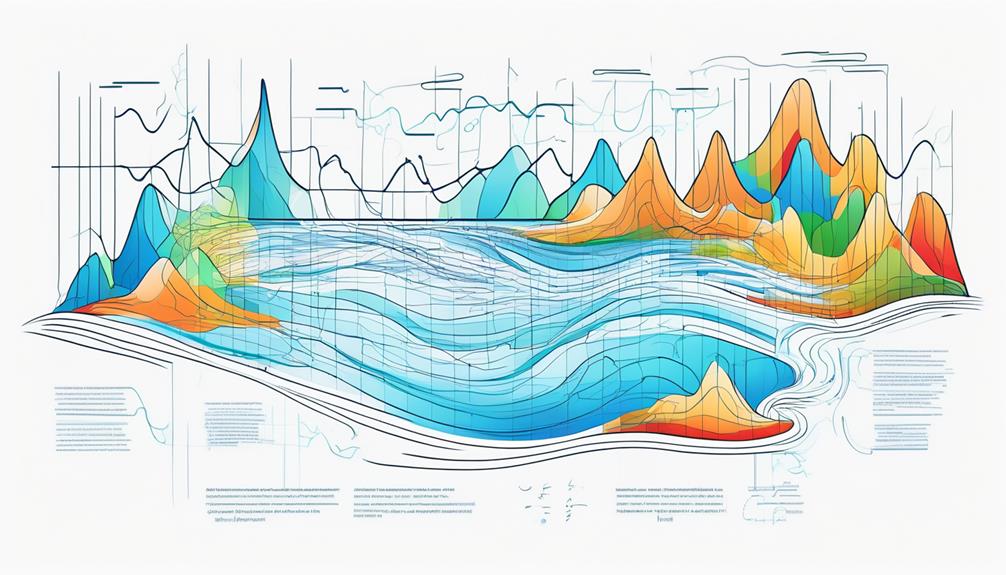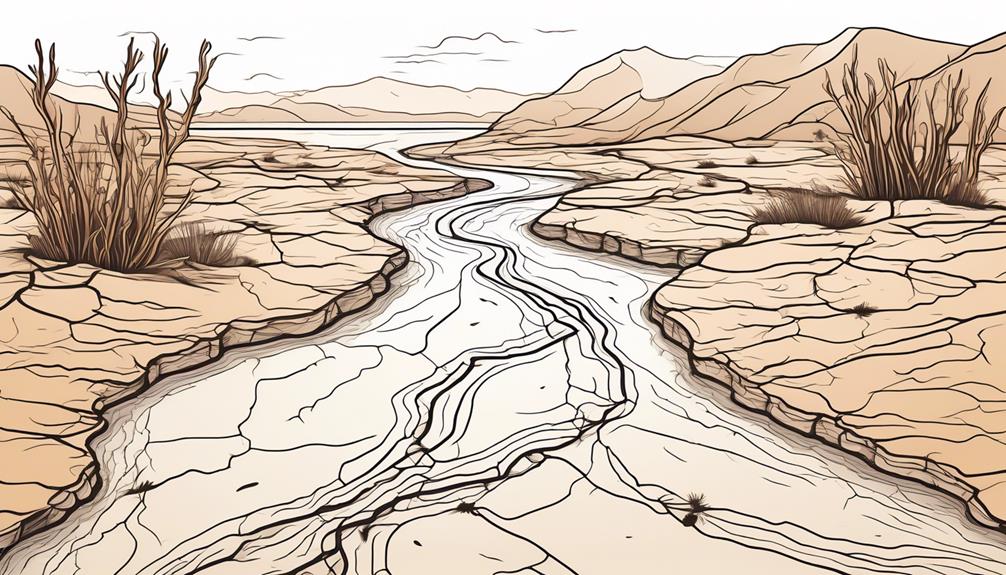Imagine a delicate web of interconnected rivers, lakes, and underground aquifers, each contributing to the intricate dance of water across the Earth's surface. In this complex system, hydrology emerges as the silent yet powerful orchestrator of water resources management.
From deciphering the patterns of rainfall to analyzing the flow of streams, hydrology's role is fundamental in ensuring the sustainable use of our most precious resource. But how exactly does this science influence the decisions that shape our water future? Let's explore the vital role hydrology plays in managing water resources and the impactful ways it guides our interactions with water systems.
Key Takeaways
- Hydrology provides essential data for decision-making processes in water resources management.
- Hydrological data collection methods revolutionize the collection of critical data on precipitation levels and streamflow.
- Application of hydrological models and data analysis is crucial for assessing model accuracy, identifying strengths and limitations, and guiding decision-making.
- Challenges such as data scarcity, climate change impacts, and the importance of sustainable practices influence water resource management decisions.
Importance of Hydrology in Water Management
In understanding the importance of hydrology in water management, you grasp the crucial role it plays in providing essential data for decision-making processes. Hydrology is like a detective, uncovering clues about water availability and quality that are vital for effective water resources management. By analyzing factors such as precipitation levels, streamflow, groundwater levels, and evapotranspiration rates, hydrology helps paint a clear picture of the water cycle and its fluctuations. This information is key in making informed decisions regarding water allocation, conservation, flood control, and quality management.
Moreover, hydrological data isn't just about numbers; it tells a story of how water moves through our environment, shaping landscapes and influencing ecosystems. Think of hydrology as a storyteller, narrating the intricate tale of water and its interactions with the world around us. In water resource management, this narrative is invaluable for predicting and managing water-related disasters, planning water supply and demand, and utilizing hydrological models to make informed decisions that benefit both people and the environment.
Hydrological Cycle and Water Resources
Uncovering the mysteries of water availability and quality through hydrology leads us to the heart of the hydrological cycle and its significance in managing water resources effectively. Here's why understanding the hydrological cycle is crucial for water resources management:
- Essential Understanding: Hydrology provides insights into the complex interactions of the water cycle, guiding decisions on water allocation, conservation, flood control, and quality management.
- Data for Decision-making: Critical data on precipitation levels and streamflow obtained through hydrology is vital for planning water supply and demand, ensuring sustainable management practices.
- Modeling Water Dynamics: Hydrological models, representing the water cycle mathematically, simulate and predict water flow and availability, aiding policymakers in making informed choices.
- Adapting to Challenges: Despite challenges like data scarcity and climate change impacts, ongoing advancements in research and technology enhance hydrology's role in improving water resource management practices.
Understanding the hydrological cycle through hydrology is key to ensuring the sustainable use and management of water resources for future generations.
Hydrological Data Collection Methods
Alright, let's talk about the key points in hydrological data collection methods.
You'll explore the significance of field measurements, the innovative remote sensing technologies used, and the crucial aspect of ensuring data quality.
These elements come together to provide a comprehensive understanding of water resources management, aiding in informed decision-making.
Field Measurements Importance
Field measurements serve as the foundation for accurate hydrological data collection, playing a vital role in water resources management. Here's why they're crucial:
- Precision: Field measurements ensure precise data on water levels, flow rates, and quality.
- Understanding: Methods like stream gauging help in comprehending water availability and distribution patterns.
- Predictions: Accurate field measurements are essential for forecasting and managing water-related disasters.
- Decision-making: Hydrological data collected through field measurements is integral for informed decisions in water resource management.
Remote Sensing Technologies
Using advanced technology, remote sensing methods revolutionize hydrological data collection for enhanced water resources management. These technologies employ sensors on satellites, aircraft, or ground-based platforms to observe precipitation, evapotranspiration, and surface water, aiding in monitoring changes in land use and vegetation cover.
By integrating remote sensing data with hydrological models, predictions of water availability, flood risks, and drought monitoring become more accurate. This integration provides a cost-effective and efficient way to gather large-scale hydrological data, supporting informed decision-making in water resources management.
Remote sensing technologies play a crucial role in advancing hydrology and improving the understanding and management of water resources on a broader scale.
Data Quality Assurance
Ensuring the accuracy and reliability of hydrological data is paramount in water resources management. When it comes to managing water resources effectively, maintaining high data quality standards is essential.
Here are some key steps in data quality assurance for hydrological data collection methods:
- Proper calibration and maintenance of equipment to uphold data quality.
- Following standardized protocols and procedures to minimize errors.
- Implementing quality control measures like regular inspections and data validation.
- Providing continuous training and supervision for field personnel to maintain high standards.
Application of Hydrological Models

So, you're diving into the world of hydrological models. Let's talk about how these models are put to work.
Picture this: we're going to explore how accurate they are, what kind of data they need, and ways to tweak their settings for better results.
Ready to unravel the mysteries of hydrological modeling?
Model Accuracy Assessment
To evaluate the accuracy of hydrological models, comparing their predictions with observed data is a crucial step in understanding their performance. When assessing model accuracy, several statistical measures play a significant role:
- Root Mean Square Error (RMSE): This metric quantifies the differences between predicted and observed values, providing a measure of the model's accuracy.
- Coefficient of Determination (R-squared): R-squared assesses how well the model predicts variations in the observed data, indicating the proportion of variability captured by the model.
- Replication of Hydrological Processes: Models are evaluated based on their ability to simulate real-world hydrological phenomena accurately.
- Identifying Strengths and Limitations: Accuracy assessments help in recognizing where models excel and where improvements are needed for better water resources management.
Data Input Requirements
For hydrological models to effectively predict water flow and availability, precise and dependable data inputs are essential. Factors such as precipitation levels, streamflow, groundwater levels, and evapotranspiration rates play a critical role in shaping these models.
Integrated Water Resource Management relies heavily on accurate data inputs to establish a comprehensive understanding of the water budget. Field collection of hydrological data is crucial to provide the necessary information for these models. These mathematical representations of the water cycle serve as the foundation for planning and decision-making in water resource management.
However, challenges like data scarcity and the impacts of climate change can hinder the acquisition of reliable data for hydrological models, emphasizing the importance of robust data collection methods.
Sensitivity Analysis Techniques
Understanding the significance of sensitivity analysis techniques in hydrological modeling enhances the precision of water resource management decisions. Here's why it matters:
- Assess Impact: Evaluate how variations in model inputs affect model outputs.
- Identify Influential Parameters: Pinpoint the most critical parameters in hydrological models.
- Guide Calibration and Validation: Assist in understanding model behavior and refining model processes.
- Quantify Uncertainty: Measure the uncertainty in model predictions, aiding informed decision-making in water resources management.
Challenges in Water Resources Management

When managing water resources, tackling data scarcity becomes a crucial challenge in hydrology. The lack of sufficient data hampers decision-making processes and the implementation of effective water resource management strategies. Additionally, the looming impacts of climate change further compound these challenges.
Rising temperatures, shifting precipitation patterns, and more frequent extreme weather events all threaten water resources and management practices. To address these complex challenges, integrated water resource management approaches are essential. By incorporating various disciplines and stakeholders, a more holistic understanding of the issues at hand can be achieved, leading to more sustainable water management solutions.
Despite these obstacles, advancements in research and technology are continuously improving practices within the field of hydrology. Understanding the intricate relationship between climate change and water resources is paramount for developing effective management strategies that can safeguard this invaluable resource for future generations.
Sustainable Practices in Water Management
Implementing sustainable practices in water management involves utilizing efficient water conservation techniques to minimize wastage and ensure long-term availability. To achieve this, consider the following key strategies:
- Efficient Water Use: Embrace technologies and practices that reduce water consumption, such as using water-saving fixtures and optimizing irrigation methods.
- Alternative Water Sources: Explore options like rainwater harvesting and water recycling to diversify water sources and decrease reliance on traditional supplies.
- Pollution Control: Implement policies and regulations to manage pollution effectively, safeguard water quality, and preserve aquatic ecosystems.
- Community Engagement: Collaborate with stakeholders and communities to raise awareness about sustainable water management practices, fostering a collective effort towards long-term water resource sustainability.
Frequently Asked Questions
What Is the Role of Hydrology in Water Resource?
In water resource management, hydrology plays a vital role by providing crucial data on water availability and quality. This data helps in planning water supply, managing floods, and making decisions based on water flow predictions.
Why Is the Hydrologic Cycle Important in Water Resources Development?
In water resources development, the hydrologic cycle is essential. It regulates water availability and distribution. Understanding it helps plan for future needs. Proper management ensures sustainable water usage. Hydrology plays a vital role in effective water resource management.
What Is Hydrology and Why Is It Important?
Hydrology, crucial for water management, studies water movement and availability. It predicts floods, manages demand, and helps in disaster planning. Hydrology guides infrastructure design for effective water storage and distribution. Understanding it is key for sustainable water resources.
What Is the Difference Between Hydrology and Water Resources Management?
In the difference between hydrology and water resources management, hydrology focuses on studying water occurrence and distribution, while water resources management involves planning and operating water systems. Hydrology provides data, and management makes decisions.
Conclusion
In conclusion, hydrology plays a crucial role in water resources management by providing essential information for decision-making. Despite potential challenges in data collection and modeling, sustainable water management practices can be implemented to ensure efficient use of resources.
By understanding the hydrological cycle and utilizing accurate data and models, we can effectively address water allocation and usage issues. Trust in hydrology to guide you towards sustainable water management solutions.
